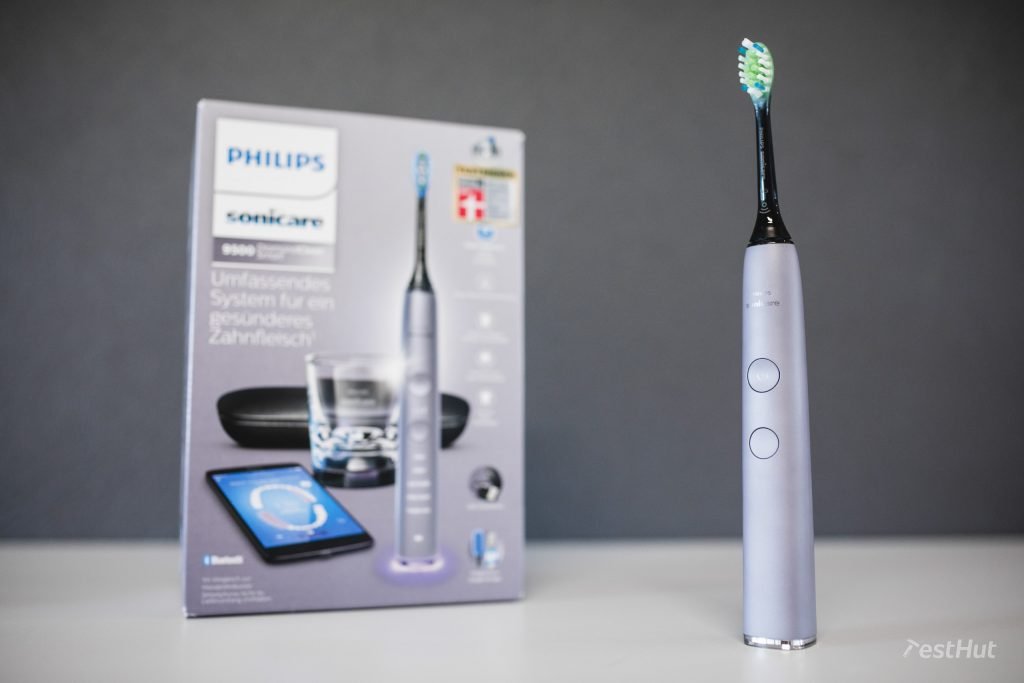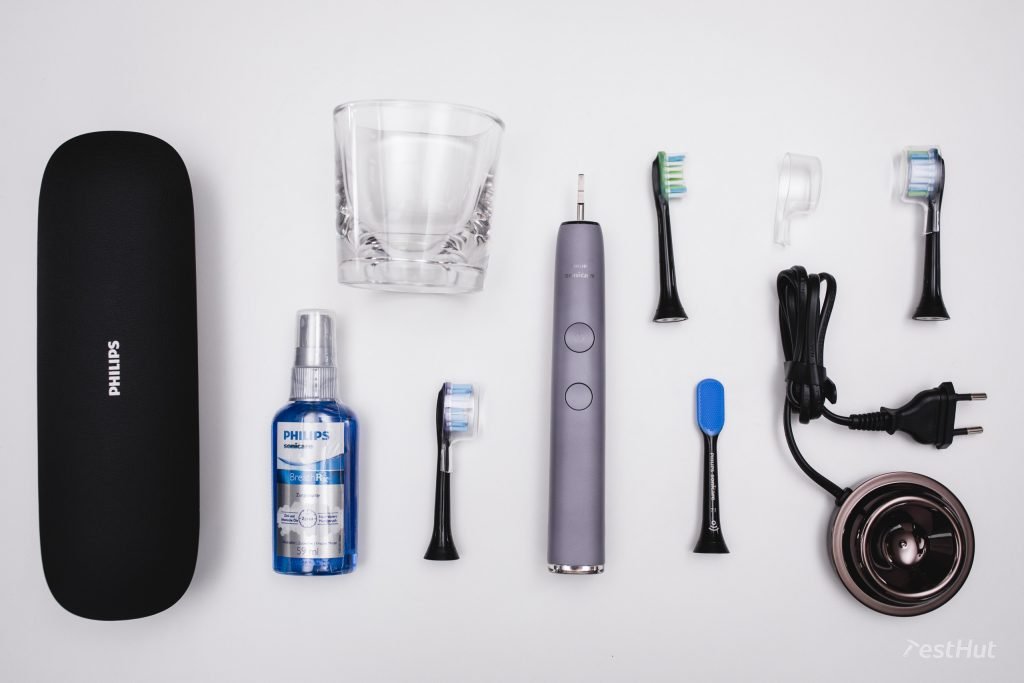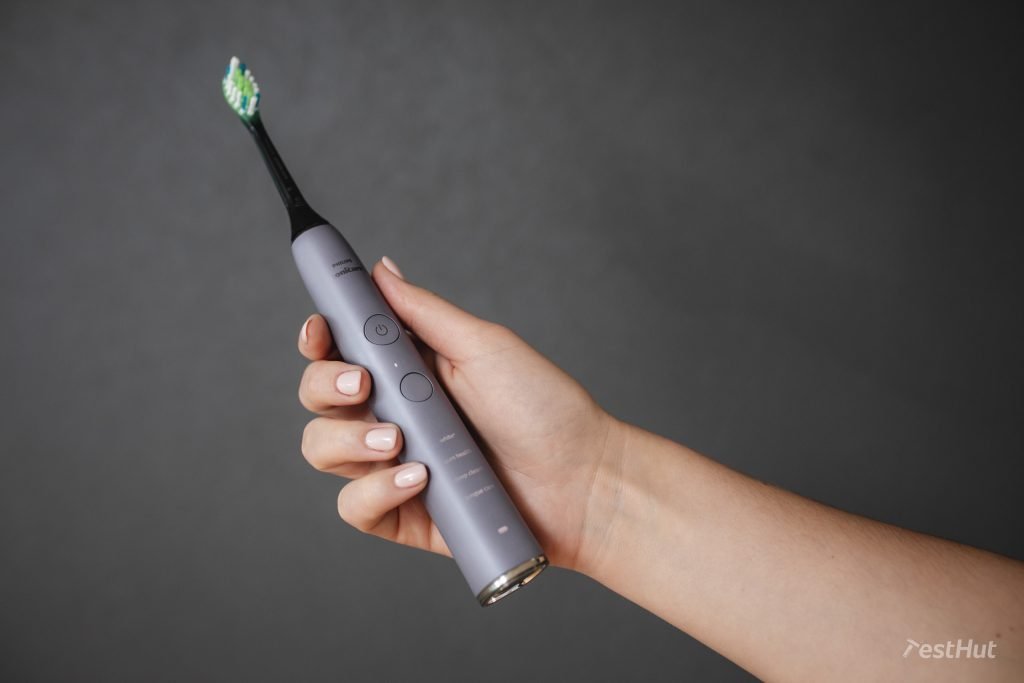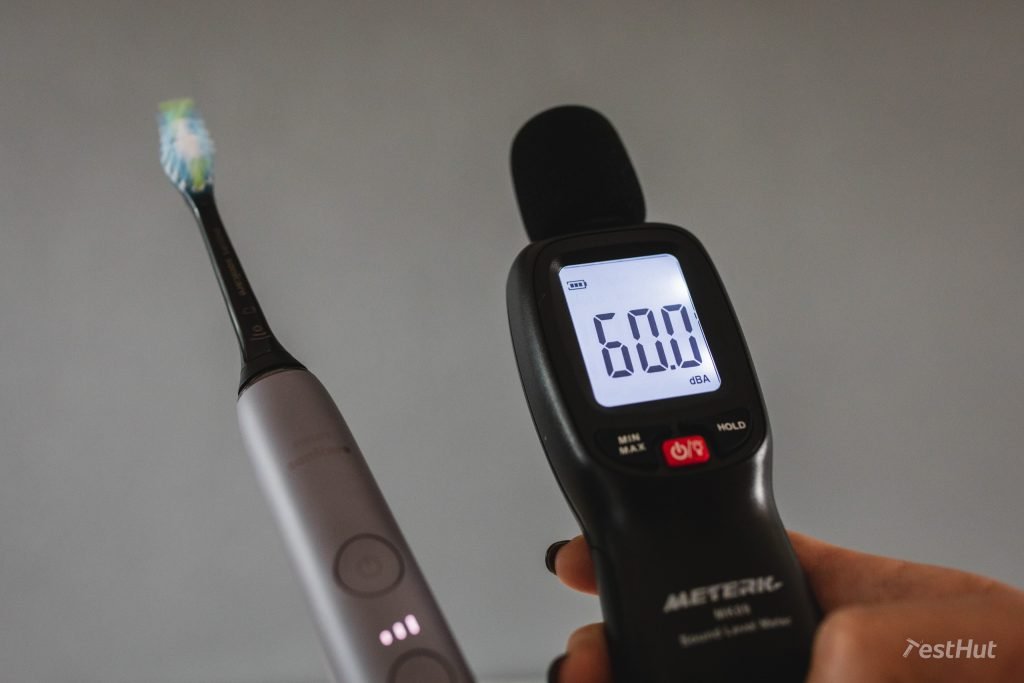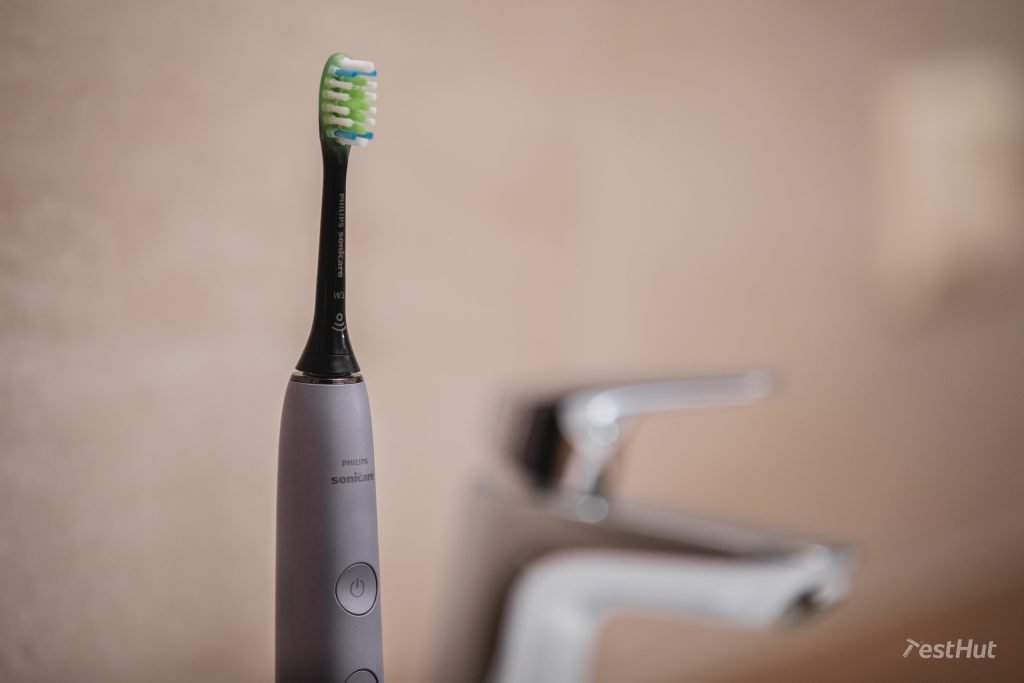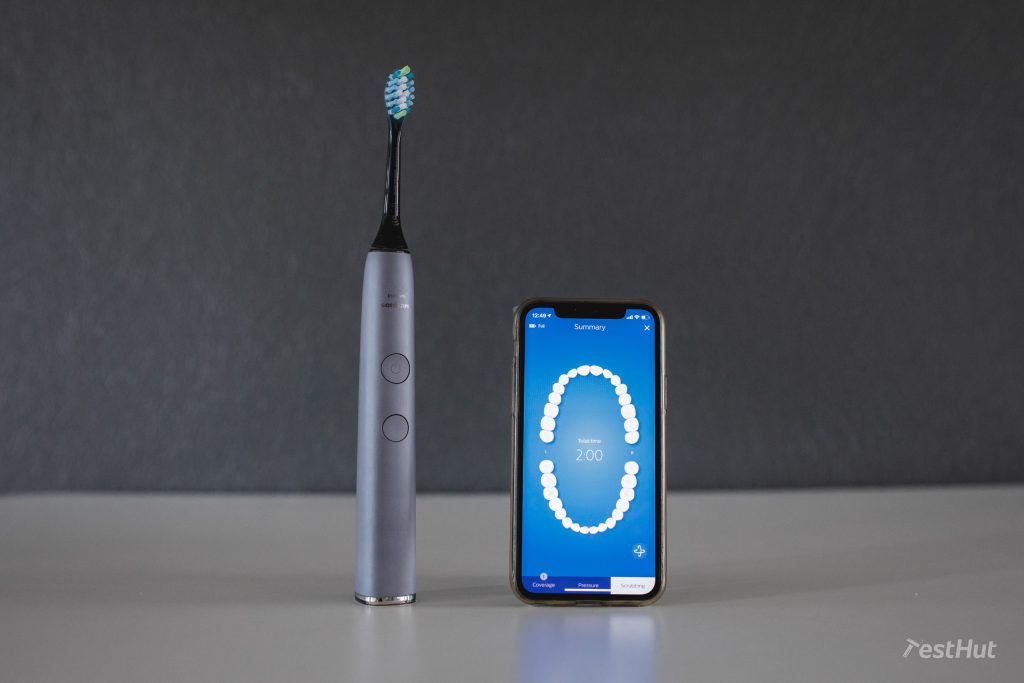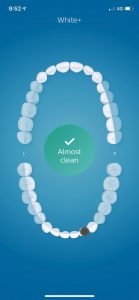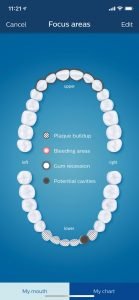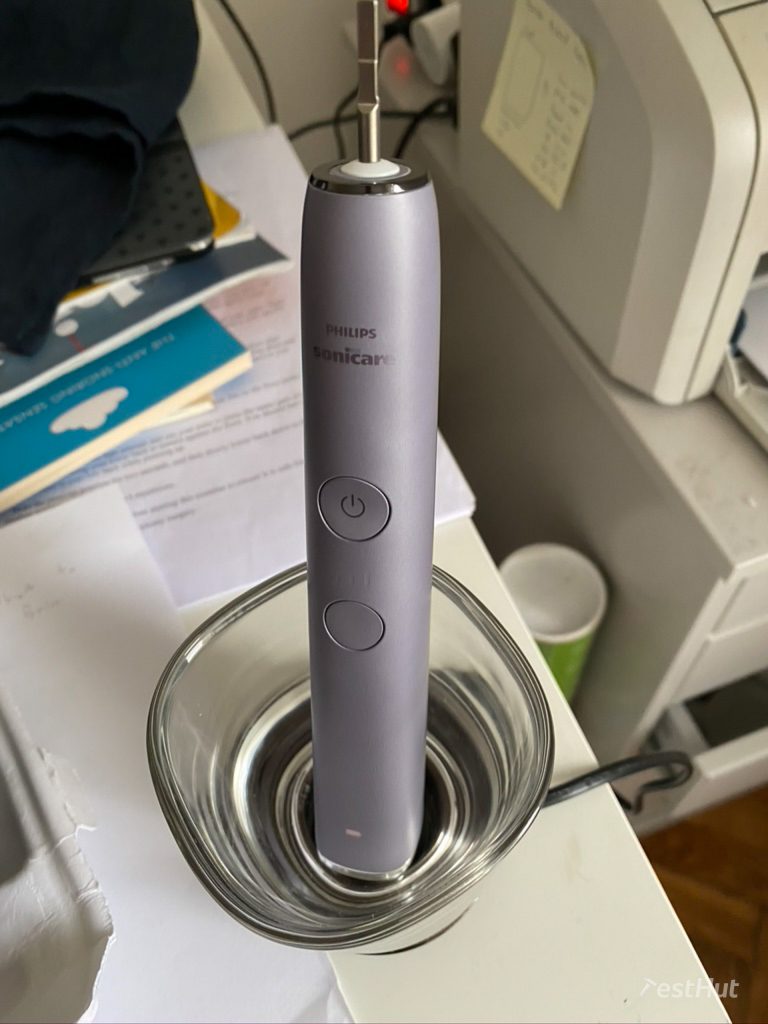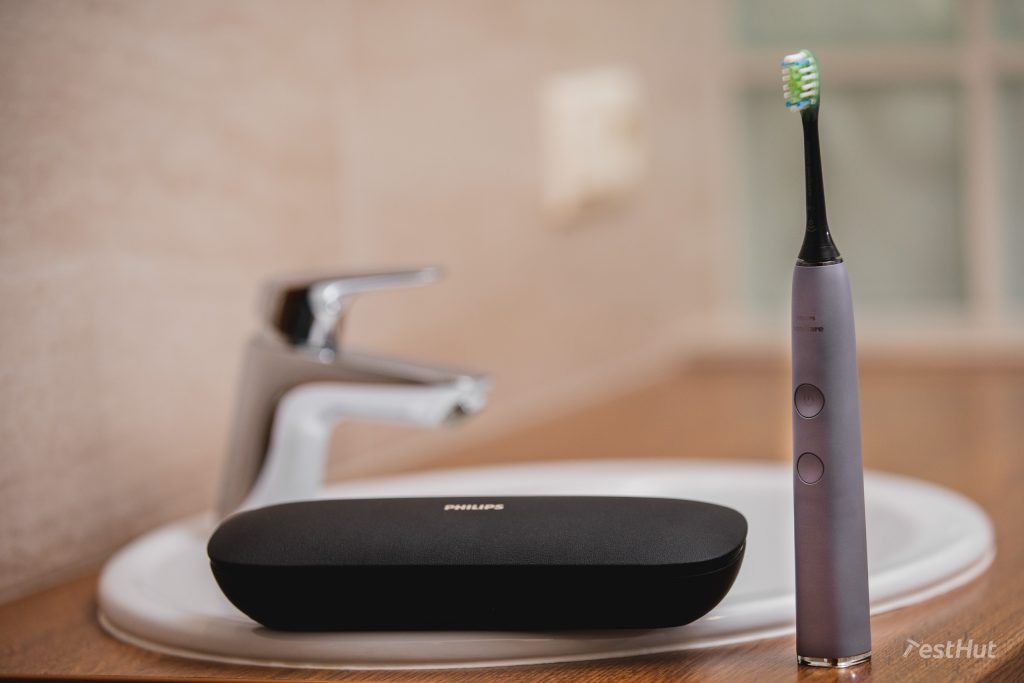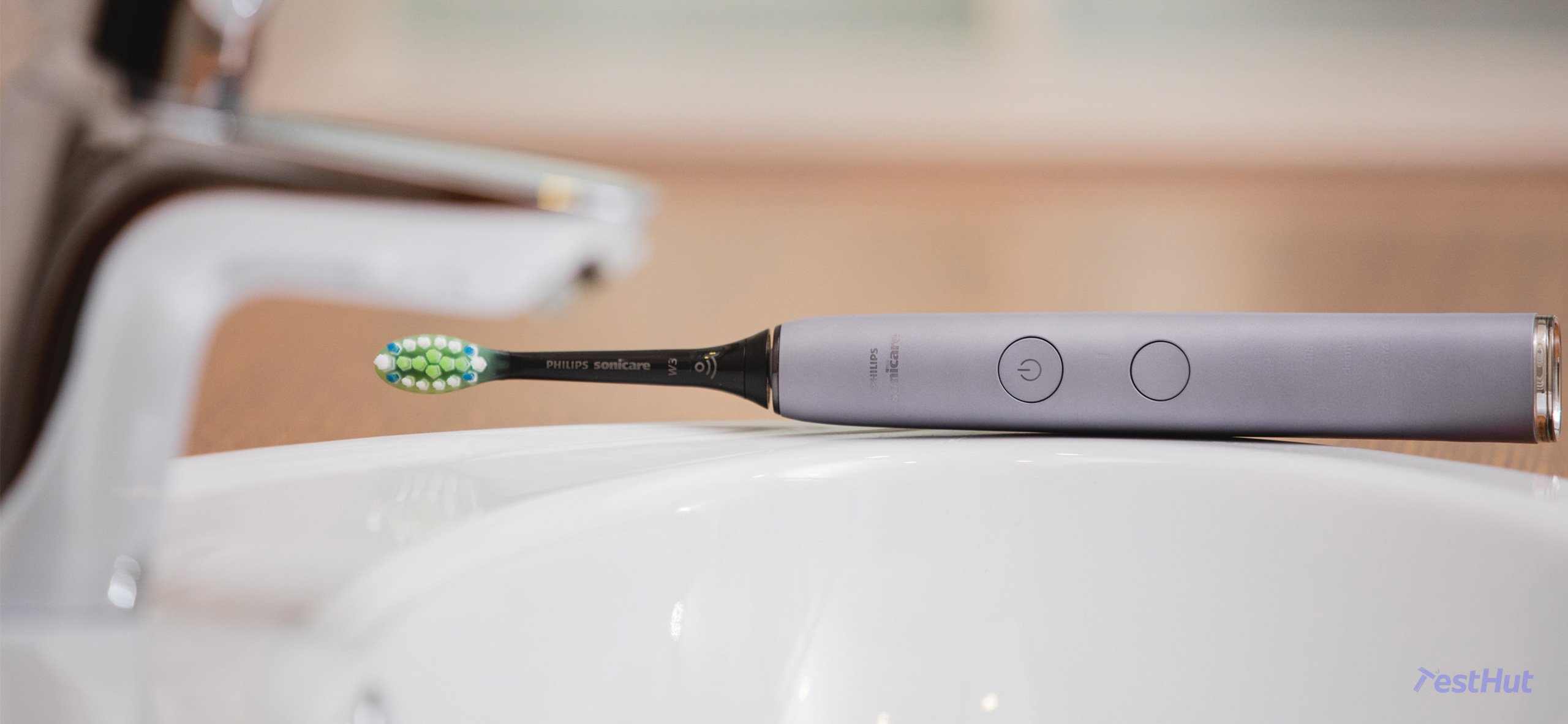
Philips Sonicare DiamondClean Smart Review: All That and a Charging Cup
For the person who thinks they have everything, may we suggest a top-of-the-line, luxurious toothbrush from Philips: the Sonicare DiamondClean Smart. We wanted to test the best toothbrushes on the market, so we ordered a lovely cashmere grey model (HX9924/44) with all the goodies. How is the most expensive toothbrush you can buy*? Spoiler alert: The test did not go well! (But we still love this brush!)
Philips Sonicare DiamondClean Smart Test results
Pros
- Effective, comfortable cleaning
- Pleasure to use
- Real-time brushing coach (great for first time electric toothbrush users)
- Stylish travel case with USB charger
- Luxurious design
- Great customer service
- Long battery life (29 days after repeated testing)
- Wide variety of brush heads available
Cons
- Expensive brush heads
- High Price
- App interface feels dated
- Dirt can damage the button functions
- First test model stopped working
One Job: Cleaning your teeth
At TestHut, we expect the products we test to do at least one thing well. We narrow our focus to the main feature to see if it actually does this one thing at a high level. In this test, we focused on how these brushes cleaned our teeth. We are happy to report that the DiamondClean Smart toothbrush does an excellent job at destroying plaque and keeping your mouth fresh and clean.
In test after test, our Sonicare toothbrushes demonstrated power and comfort while cleaning. The catch is that you get pretty much the same effect from any new Sonicare brush, so the big question is which electric toothbrush is best and what does 240 pounds (price we paid) get you? Let’s find out.
Unboxing
Although the packaging of the DiamondClean was not as premium as some of the other electric toothbrushes we tested, we appreciated the minimal approach to using recycled cardboard and only a small amount of plastic.
The brush comes with a nice array of accessories. When you add them all up, they still don’t quite justify the price tag, but they make it easier to defend. The package comes with a tongue cleaning kit that sells separately for about 23 pounds along with three brush heads which cost about 9 pounds apiece. They throw in the deluxe case and a cool charging cup, so you have lots of bells and whistles when you unbox this brush.
The Sonicare product line is quite extensive and can be confusing. This DiamondClean Smart (HX9924/44) is actually the older version of the brush; the newer version, the HX9924/14 or HX9901/14, comes with fewer accessories at a lower cost. There is also the DiamondClean series without the “Smart” moniker which is much less expensive, but does not offer any bluetooth connection or app capability. All of them come in a variety of colors.
Look and feel
Philips seems to really understand the concept of minimalism in their styling. This cashmere grey handle is wrapped seamlessly in sleek, polished plastic. Unlike the Oral-B brushes which seem to be made of 2-3 different kinds of plastic and rubber, this is just one color and texture. The base has a purple LED light which acts as the pressure sensor, and LED lights on the handle tell you which mode you are in using a nice easy-to-read font. The words are all in English, which might be a drawback on the international market, but we find it easier to understand than the cryptic hieroglyphics of the Oral-B Genius line.
The battery light could be more functional. As it is now, it softly glows when it is full, and then begins to blink as the charge decreases. The blinking is a bit hard to detect in a well-lit room. We would prefer battery bars that tell us more precisely when we need to charge our brush.
We love how stable the base is. When this brush is standing upright, it is not easy to knock down. It’s squared off corners keep it from rolling if it does tip over. All-in-all, this is a handsome, functional design that will compliment any bathroom.
Brushing experience
Have we reached peak sonic? Out of the box, we were hoping to be blown away by the performance of this brush. But once you get right down to it, it cleans just like any other decent sonic toothbrush. The brush heads that come with it are high quality, and the DiamondClean looks really nice when you put it all together. But ultimately, the feel of the sonic vibrations as you glide the brush across your teeth is very similar to the Sonicare 4300 and even some of the other sonic brushes we tested.
One complaint is that despite two buttons on the brush handle, they are not as functional as they could be. The larger top button turns the brush off and on, which is great. The second button will allow you to change modes ONLY if the brush is off. Once you turn the brush on and push the second button, then it changes the intensity of the brushing. To switch from one mode to the next, you have to turn the brush off. We found that changing the intensity of our sessions was a pretty useless feature. However, it would have been nice to be able to move from mode to mode while brushing to feel the differences and to finish with a nice gum massage or tongue cleaning.
When you power it up, the brush emits a decent amount of noise (60 decibels), but it isn’t any more than you would expect for a handle this powerful. When it cranks out 62,000 vibrations a minute, there is bound to be some commotion.
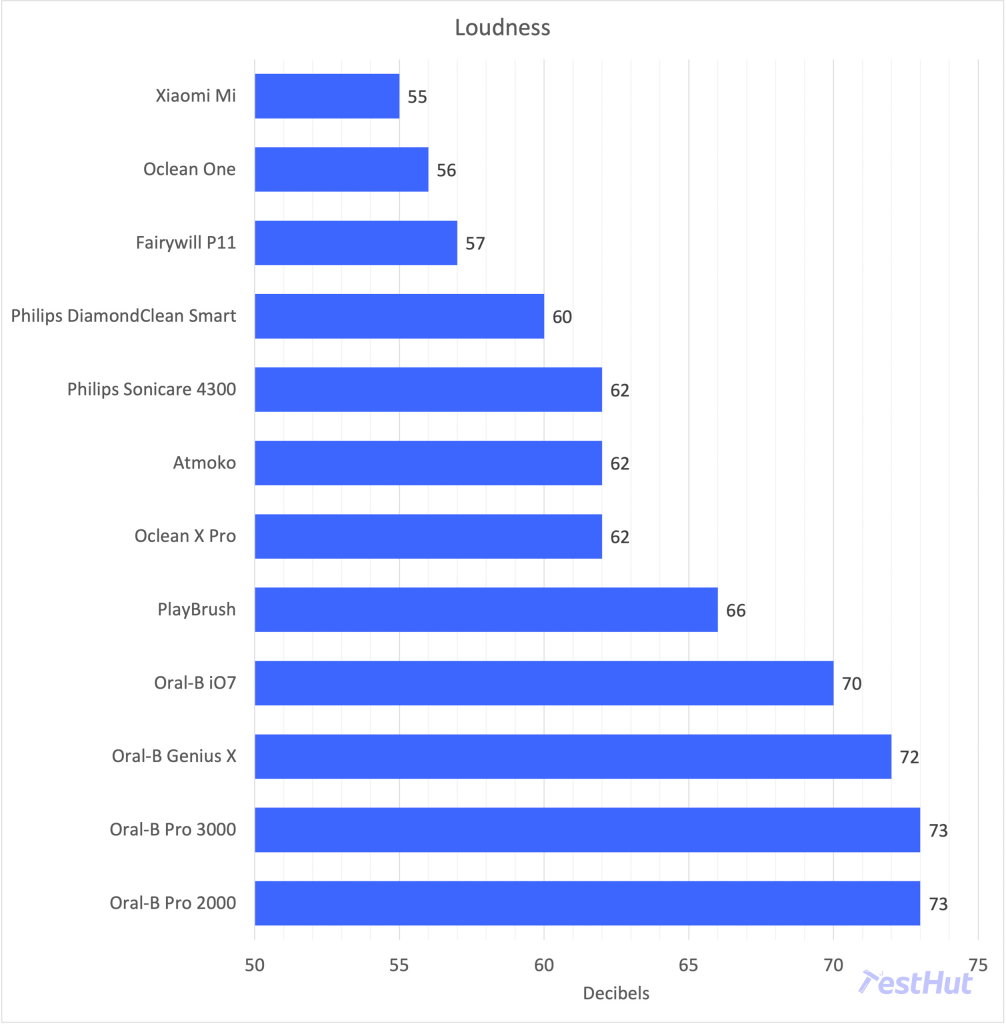
Unlike most other brushes, instead of a quad pacer that divides a two-minute brushing session into four 30-second intervals, the DiamondClean divides the time into 6 20-second sessions having you move the brush a little more frequently as you brush. This makes the brushing seem less tedious, but it takes some getting used to.
When paired with the app, the 6 sections immediately make sense, but if you are used to quad pacing, you want to rethink how you brush. The manual shows a small image of how the 6 sectors work, but it really helps to follow along with the app.
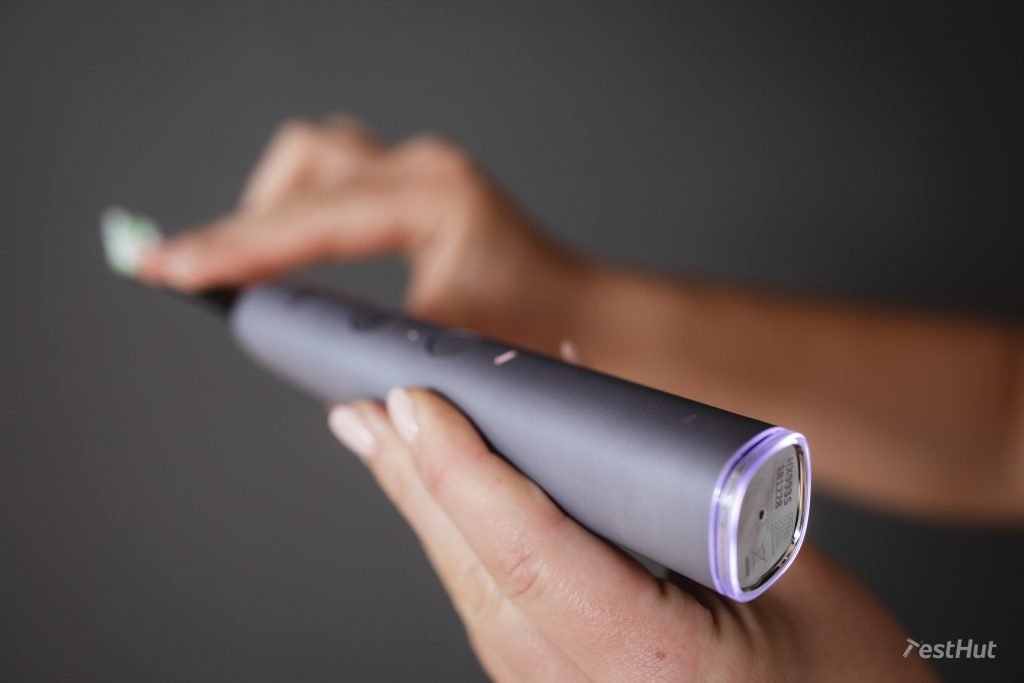 The brush has a pressure sensor that accurately engages at about 300 grams of force. The industry standard is between 250-300g., so this brush is spot on. The base will blink if you push too hard and the brush head will slow down and vibrate. We found that this was an excellent way to tell us to ease up on the scrubbing. Some people complain that they don’t like the pressure sensor, and if you are one of those people, you will be happy to know that you can disable it by following the instructions in the manual.
The brush has a pressure sensor that accurately engages at about 300 grams of force. The industry standard is between 250-300g., so this brush is spot on. The base will blink if you push too hard and the brush head will slow down and vibrate. We found that this was an excellent way to tell us to ease up on the scrubbing. Some people complain that they don’t like the pressure sensor, and if you are one of those people, you will be happy to know that you can disable it by following the instructions in the manual.
Brush head syncing
One feature that gave us mixed feelings are brush heads with a built-in electronic chip. The idea is that your DiamondClean Smart can actually tell exactly which brush head you have equipped it with and it will automatically change the mode to match the brush head (Smart brush head recognition). So if you want to whiten your teeth, you can attach the W3 (Premium White brush head) and the brush will automatically switch to whitening mode. This is pretty cool. And if you don’t like the mode it has selected for you, you can override it with a push of the mode selection button.
The chip also keeps track of how many times you have brushed. So the app will show you exactly how many brushing sessions you have left based on the recommended 3-month longevity of any brush head. You can override the warning to replace the brush head if you want to, but it is nice to know exactly how many times you have used your brush.
Now the problem is that all this technology comes at a cost. The Philips brush heads were the most expensive ones we tested (except for the newest Oral-B iO brush heads). And if you buy knock-off brush heads, they will not have the chip, so you will be missing out on some of the smart brush features you paid a premium for. It is a bit of a Catch-22. But we guess that if you can afford this brush in the first place, you might not be so concerned about paying 9 pounds every 3 months for a replacement.
Battery life (And unexpected problems!)
The battery lasts longer than expected. Philips claims that one charge will last at least two weeks, but we got 74 2-minute sessions from one charge and that’s over 3 weeks of brushing! Now if you are brushing with bluetooth each time and touching up when the app tells you to, then this will likely cut down on your battery life, but it is at least as good as advertised.
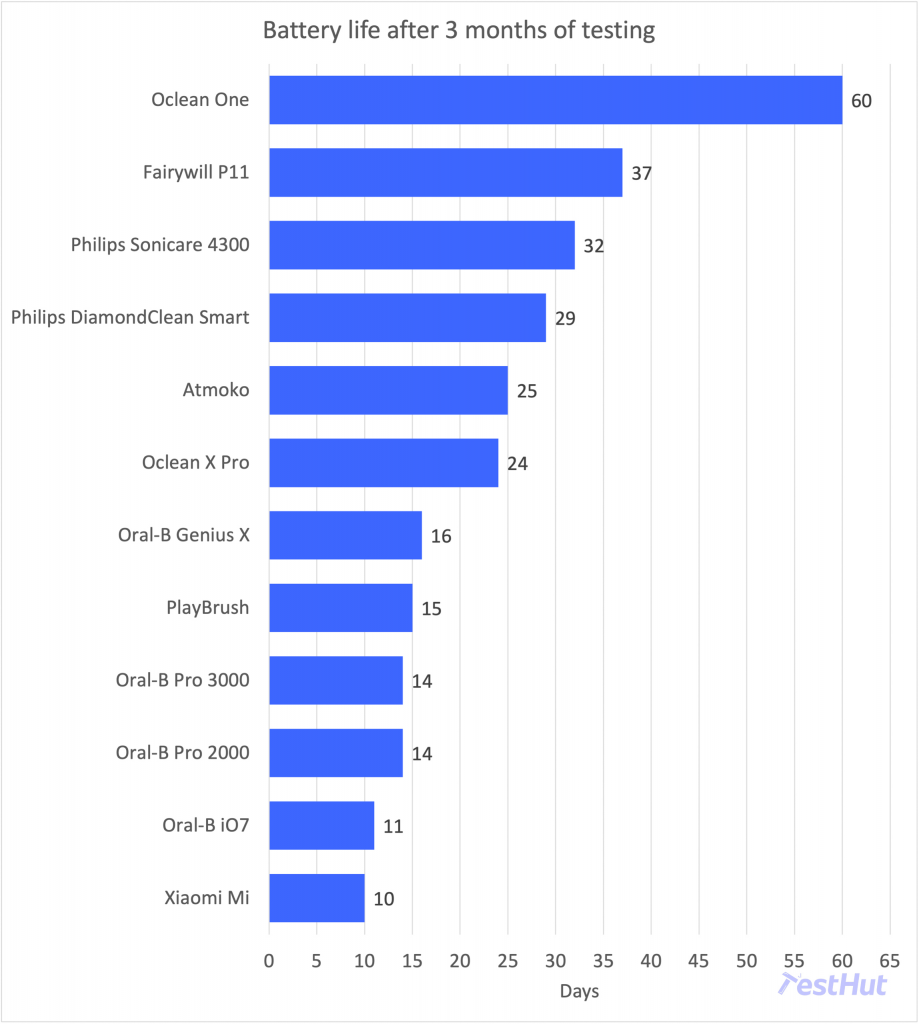
However, we had a major issue with the brush after our initial testing session. After completely discharging the battery, we put the DiamondClean on its charging cup and let it charge fully. Then, the next day, when we tried to turn it on, there was nothing. It didn’t make a sound. The battery was full, but the brush would not turn on. We tried everything, but it seemed that our DiamondClean was dead.
We have read many customer complaints about this model failing after several months, but after just one charge? This was unexpected to say the least.
We can report that Philips’ customer support was excellent. We were told to take the handle to a local certified repair shop. They took one day to assess that it could not be repaired, and we had an identical replacement ready for pick up within 2 working days. There was no charge to us, so it was really just a blip of inconvenience for our tests.
Update: The new model worked perfectly throughout our testing and is still going strong after over 6 months in our long-term test.
When the battery is empty, this brush gives you two options. You can charge it using the included charging cup with the induction base or you can charge it in the deluxe travel case using a short but handy USB cable. It does not include a USB charging brick, but you can plug it into any standard one or your laptop or other device with a standard USB port.
What else does it do?
At first, we were delighted by the Philips app because of its clean appearance and ease of use. However, it was harder to start using than the Oral-B app, requiring a login email and password. The brush connected immediately and it was ready to show us how to improve our brushing habits.
According to the manual, “Using the Philips Sonicare app will help you to improve your oral health habits.” With real-time feedback, it can show you what you are doing right and wrong while brushing and teach you a better way.
Coaching
We liked the coaching app for the most part. Basically, it senses that you are starting a brushing session, and then you follow the on-screen tips as you brush and move through the six sections of your mouth for 20 seconds at a time. Even after using a Sonicare for years, I felt like I learned how to brush better after only a few tries. One issue that I overcame was “too much scrubbing.” With an electric toothbrush it is important to let the brush do the work as you gently move it around your mouth slowly and carefully. One problem is that the app seems to only collect data when you brush the fronts and backs of your teeth, but does not record or display when you polish the chewing surfaces.
After the two minute session, the app will tell you where you need to touch up. The brush handle automatically shuts off, but then encourages you to turn it back on to put a bit more effort into those parts of the mouth that need more work. We really liked this feature, but we are not sure if it was always 100% accurate in detecting where the brush was as we were brushing. We also don’t like that it only detects when you are brushing the section of the mouth that is highlighted during the 20-second interval. If you decide to brush somewhere else, the app just thinks you are not brushing at all. On the other hand, the Oral-B app quickly adjusts if you move your brush around and keeps track of wherever you brush. We aren’t sure why Sonicare demands that you follow their lead.
We can see a new user enjoying this app for a few weeks as you come to understand how to use a sonic brush and to make sure that you are doing it right. But once you have the habit down, the app doesn’t offer much more. It has a weekly progress chart and goals. The goals will set the brush settings to try to help you improve a specific area of your oral health including Gum health, Plaque removal, Whitening, and Fresh breath. You can even create custom goals, but the customization feature really doesn’t allow you to do much.
Other features
We would expect a brush at this price to allow you to customize and brush exactly how you want to brush. You should be able to program the time (many brushes allow from 2-4 minutes), the mode, and additional features like a tongue cleaning at the end of the session. But instead you only get to choose from 3 pre-programmed features like “Time: Brush for 2 minutes” or “Frequency: Twice a day”. You can’t even change the time or frequency if you want to. This just feels like laziness on the part of Sonicare.
You can also set “Focus areas” by selecting parts of your mouth that might have more plaque or bleeding gums, but we are not sure exactly how doing this affects brushing sessions. The Focus areas appear on the mouth map as you are brushing, so this may be a good reminder to really get those parts of the mouth clean as you go through your oral routine.
The app also lets you shop for products like brush heads which is nice, but something as simple as checking battery life takes 3 clicks and is kind of hidden in the settings. Other apps will display the battery life whenever the app is open and the brush is connected.
Overall, we are not sure how smart this brush really is. It does not seem to learn or really personalize the app to suit your needs. We would like a brush in this price range to offer more customizability and AI-type features that would really conform to your brushing style and help you improve. Other brush apps also include goals and rewards for good brushing habits, while this app does not. Over the long term, we don’t see much use for the app.
Modes
Just like the other high-end brushes, Sonicare is in a mode war trying to convince us that we should pay more for an electric brush that offers more modes. The DiamondClean Smart offers 5 modes, and for each mode you can customize the intensity from 1-3. Doing the math, this gives you 15 different ways to your teeth! Is this important? Not really.
We found that most of the time, we would just use the standard clean mode as this offers a full-power session for 2 minutes which is the industry and dentist-recommended standard.
The white+ mode vibrates a little differently than the clean mode, and it adds 40 seconds to the total brush time reminding you to scrub your top and bottom front teeth a little longer. Is it effective? We aren’t sure, but we didn’t see a difference in our plaque tests.
The gum health mode gives you a regular 2-minute cleaning and then slows down to give a softer vibration for massaging gums for another 1:20 for a total cleaning time of 3 minutes 20 seconds, while the deep clean+ mode has a strong punctuated vibration similar to the White+ polishing mode and lasts for 3 minutes. We would like to be able to select a gum care mode that would give us a gum massage without having to perform a full cleaning first.
The tongue clean mode is a special, gentler session that lasts just 20 seconds, but is worth it for the sparkling graphic on the app. With the included mouthwash, it gives you a nice feeling of freshness, and maybe a spark of confidence.
We like that the modes not only change the vibration of the brush handle, but also the time of brushing so you are getting a different experience, but as with any brush, we feel like modes are overstated as features to try to upsell the higher-end handles rather than offering a truly helpful oral care experience.
Brush heads
Oral-B and Philips offer the most brush heads for their products. There are so many to choose from, in fact, that the Philips home page has an advisor to help you choose the best brush head for you!
Basically, there is the ProResults line which is the legacy brush head that used to be the standard. It is smaller and comes without a chip at a lower cost than the newer brush heads. Then there are the x2 series and x3 series. Each of these offers a whitening brush (W2 or W3), a plaque brush (C2 or C3) and a gum care brush (G2 or G3) which we would also call their sensitive brush head.
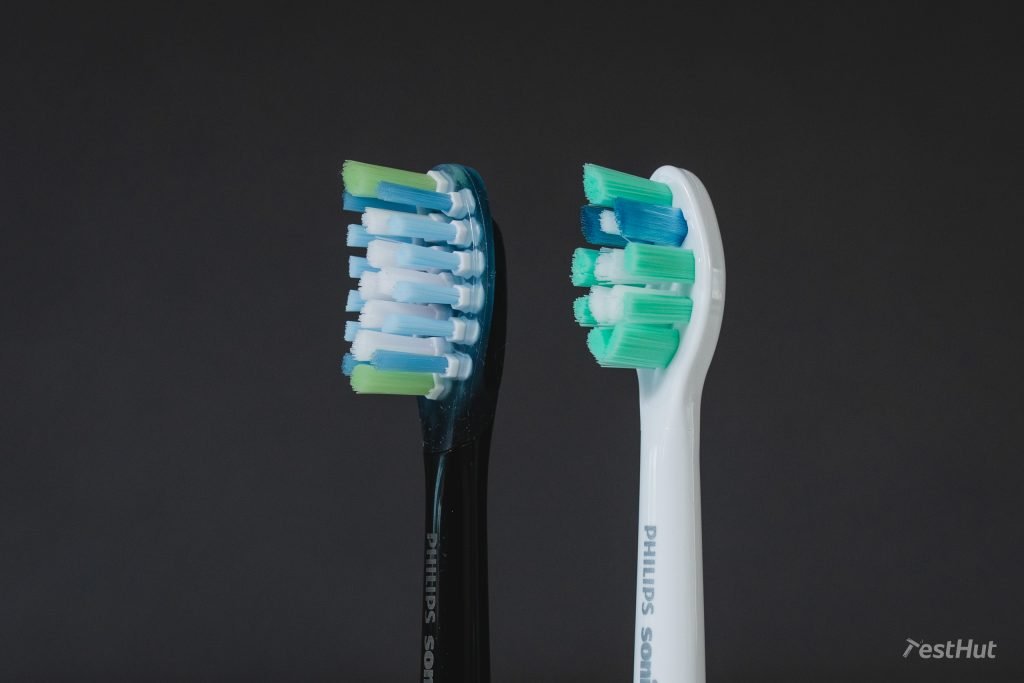
The 3-series heads are the newest and most advanced and they also come in both the fashionable black color and the more traditional white. But you can get by using the 2-series and even the ProResults (as long as they are still in stock).
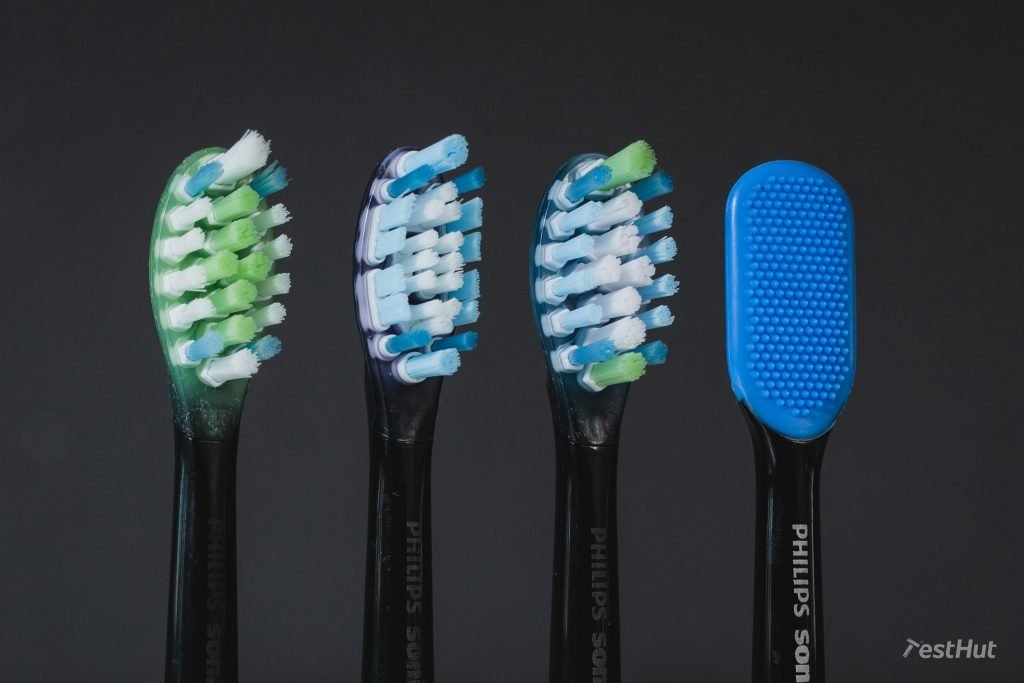
We tested the 3-series heads that came with the brush handle and the 2-series heads as well. There didn’t seem to be any big difference in the way these brush heads cleaned our teeth, so it comes down to personal preference. Both the 2 and 3-series come equipped with a chip, so your handle will automatically pair with them. Many people prefer the older ones (series 2) because they are cheaper and smaller, but we liked the look of the 3-series heads which also have a nice soft silicone bumper on the sides which some users may find more comfortable.
Accessories
The DiamondClean Smart comes with a nice compliment of accessories. The most notable one is the deluxe travel case, which we think is the best travel case of the ones we tested. It is sleek and has a magnetic seal that keeps it closed tightly. There is room for the handle and two brush heads. A secret compartment on the bottom reveals a USB cable that can be plugged in to charge the brush on the go. The package does not come with a USB charging brick, but this will work with any USB outlet you might have (Laptop, phone charger, etc.) The case itself does not have a battery, so you must plug in the USB cable to charge the brush when traveling. One problem is that the cable is pretty short 60cm, but overall, the case is nice and will keep your precious toothbrush safe while on the go.
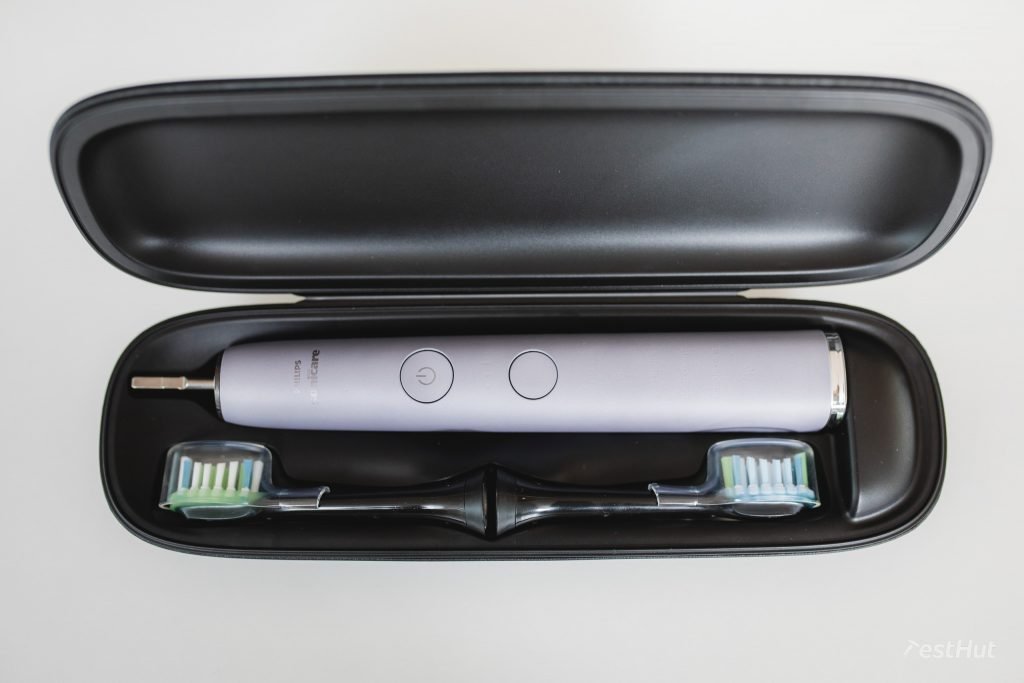 The most unique accessory that Sonicare provides is the charging cup. Rather than giving this special brush a simple induction charging base like most other brushes, this one gets a glass cup to rest in that sits on a special induction brick to charge like royalty, reclining in luxury. We love the concept of this and having a nice glass cup for rinsing is definitely a bonus. However, the glass is pretty bulky, and in a small bathroom, it might be hard to find a safe place for it to sit. We would like a standard base as well with a smaller footprint, and you can buy one separately, but it would have been good (especially at this price) for it to be included.
The most unique accessory that Sonicare provides is the charging cup. Rather than giving this special brush a simple induction charging base like most other brushes, this one gets a glass cup to rest in that sits on a special induction brick to charge like royalty, reclining in luxury. We love the concept of this and having a nice glass cup for rinsing is definitely a bonus. However, the glass is pretty bulky, and in a small bathroom, it might be hard to find a safe place for it to sit. We would like a standard base as well with a smaller footprint, and you can buy one separately, but it would have been good (especially at this price) for it to be included.
This brush also comes with 3 brush heads (2 C3 Plaque defense and 1 W3 Premium White) along with the special tongue cleanser brush head and a bottle of mouthwash. While all of these accessories do come at a premium price, it is nice to get a box full of goodies. We would have liked a softer-bristled brush head (G3 Premium Gum Care) to come standard as well. Why not give us one of each kind to start?
One accessory we would definitely add to this collection would be a brush head holder. I happened to have one from my low-end Sonicare that made storing and switching from brush head to brush head much more convenient and sanitary.
Care and long-term use
We hope that this DiamondClean Smart will last a long time, and that our first model was just a dud. However, there are many complaints that the brush does stop working after a few months, and its Achilles Heel seems to be the buttons with their small gap that allows grime and water to seep in and affect the reliability of the handle over time. So far, the second handle is clean and working fine, but we will definitely let you know if there are further issues.
Because it is made of sleek plastic, keeping it clean is pretty easy. Some gunk does like to collect at the top underneath the brush heads, but we recommend removing the brush heads and wiping this area clean after use.
The good news is that the brush is guaranteed for two years, and we did have excellent service, so even if something does go wrong, Philips will stand by their product. But for this price, we sure do want it to last as long as possible.
This brush will cost you more to operate than some other brands we tested because of the costly replacement brush heads. You can plan on paying about 9 pounds every 3 months for a replacement meaning this will cost about 36 pounds a year to operate. You can sometimes find brush heads on sale in bulk, so watch out for special deals online or at your local electronic store.
Conclusion
We really do like the Sonicare DiamondClean Smart. It is an attractive brush that really does a great job of cleaning teeth. The accessories are nice, and the whole package has a luxurious feel to it. In fact, this brush wins our Best Premium Electric Toothbrush category, if price is no object.
The app is not the best one out there, but it does a nice job of teaching you how to brush the right way, and gives you some good feedback as you clean your teeth.
We do want to remind you that despite their claims, we don’t think this brush is really all that “smart.” It does have real-time tracking to see how well you are brushing your teeth, but it doesn’t actually engage AI to learn or personalize your brushing experience. A truly “smart” brush will learn about your teeth and adjust to your habits. This brush does not do that.
The bottom line is that if you want the best brush on the market, and price is no concern, then by all means, buy the DiamondClean Smart. But if you want the same fresh and clean feeling without all the extras, then we would recommend the Sonicare 4300 as a fantastic alternative at about ¼ the cost .
